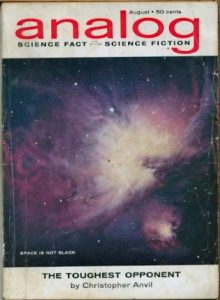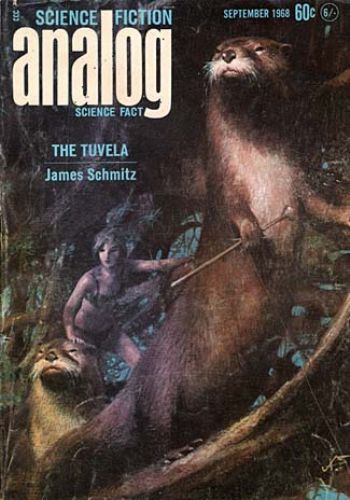Greetings all
I decided I wanted to spend time with the family last week instead of reviewing a magazine. I suspect I’ll do that again around Christmas as I had a great Thanksgiving.
Anyway, this week’s magazine review is the Analog of August, 1962. It promises to be an excellent issue with a cover story by , plus other works by James Schmitz, Mack Reynolds, and one of my favorite authors, Randall Garrett. It also has a hilarious ad on the inside cover.

Table of Contents: http://www.isfdb.org/cgi-bin/pl.cgi?56739
The hilarious ad inside the front cover is for the Remington Rand Microfilm Camera. It talks about how its unfair to SF, because it doesn’t have have enough knobs, doesn’t hum, has no green light, nor does it have an oscilloscope. Plus it weighs in at a svelte 155 pounds.
The issue begins with an essay by John W. Campbell called How to Get More Than Your Share. It’s a quick discussion of basic economics and how they apply to us all.
The first story in the issue is Christopher Anvil’s The Toughest Opponent. This is an excellent story pitting a solver of problems against a tough test. He is on a planet where the natives can eat virtually anything, meaning they really can’t run out of food. Their population explodes, but they never need to organize past the individual. As individuals, the natives are intelligent. However, he has to face them as an amorphous mob.
What I loved about this story was the solution. He found a native insect that terrified the natives during the day, but which was quiescent at night when the natives hunted them. He could, and did, use the insects as a defense to protect various enclaves around the planet. This worked, but left the situation back where they started.
So he set up these insects in defensive positions that required two or more natives to defeat. Eventually, this forced the natives to start working together, which then began the creation of tribes and larger units.
Someone mentioned that this was their toughest opponent yet, but the hero looks in the mirror and says, that’s our toughest opponent. We forget to think, and that lack of thinking is the root of all our problems. There’s a lot to that.
There was another striking quote. “The trouble with life, Towers, is that it presents an endless selection of choices between undesirable alternatives. For instance, if a man wishes to act sensibly, he should first understand the situation thoroughly. But, if he waits till he understand the situation thoroughly, the opportunity for action passes (p 12.)” I love that truism.
Next up is Randall Garrett’s The Bramble Bush. It didn’t disappoint. It’s a fission/fusion adaptation of There Was a Man in Our Town nursery rhyme.
Our main character is a nuke plant technician in a plant on the Moon. He wakes up to find that two of his co-workers are unconscious and one of their reactors is having real problems. The only other co-worker around is ineffectual and panics easily. So, he goes in to do what needs to be done.
He saves the unconscious guys and slows the reactor, but does not solve the problem. However, in the process, he forgets the chemistry of the situation and his protective suit gets covered in radioactive mercury. He needs to be able to get out of the suit in order to go back to the control center to put an end to the problem, however, a shower won’t remove the mercury from his suit, and he can only reach a small fraction of the mercury to scrub it off. If he takes the suit off, he’ll die, and if he doesn’t, the reactor will blow.
But Mercury-203 mixed with Helium-4 in a fusion reactor fuses to Lead-207, which is a stable element. So his solution is to go back into the reactor and wait until the process is completed, even though it becomes a bit uncomfortable at 350 or so Celsius. Then he simply leaves the reactor, takes off the heavy, but non-radioactive suit and goes into the control panel to set everything back to normal.
One of Garrett’s greatest skills is ending short stories, and this is a great example. During the process of solving the problem, the hero ruefully laughs that he’s a knight in shining armor. When the rescue crew arrives to find him dozing, our hero mutters, “I am a knight in dull armor” (p. 67), which is humorous enough, but then Garrett adds this brilliant bit: “Hi yo, Quicksilver, away” (p. 67).
I’ve said it before and I’ll say it again, but if you can get your hands on The Best of Randall Garrett, do it. It’s some of the best short story writing you will ever find.
Next we get to Watch the Sky by James H. Schmitz. In this story, our protagonist and other plotters arrange a hoax to further their careers. Humans have been in a war with the Geest for decades and hundreds of millions on each side have perished.
The hoax is the duplication of a Geest weapon war relic owned by the protagonist’s great grand-uncle and the subsequent “discovery” of that duplicate on his planet. It’s a backwater planet that at one point had another intelligent species on it, but is now on the other side of human space from the existing front of the war. The problem is that the duplication machine does not have access to certain Geest materials so a molecular scan proves it must be a forgery.
That puts the plotters in a bad place. This is, essentially, treason during a war, and as such is a capital crime. That isn’t all, however, as the main character discovers that the only place his ancestor could have found the weapon was on this planet, so his hoax is not actually a hoax. Worse, there’s evidence that this planet will become the focus of a new attack by the Geest.
Can’t prove it though, and they have no credibility because of their actual hoax attempt. However, in the conclusion, the government hears their theories, agrees with them, and then sets a trap. In the end, the plotters all become heroes and the Geest are slaughtered when they attack.
I’m telling this story abruptly in this blog post, but that abruptness mirrors the story. I like this story, but I would have liked it a lot more with some subtle hints of what was coming.
When I write my mysteries, once I figure out the bad guy and the ending, I always make sure there’s a subtle line of bread crumbs that, when the book is read again, make sure the reader knows the evidence was there all along and that the reader had a chance to figure it out.
I’m reading some Nero Wolfe stories and while I am enjoying them, we are not always presented with all the information we need to solve the story. That’s the case here. I would have liked more hints at the provenance of the MacGuffin.
Also, the transition from bad guy to good guy at the conclusion was too fast. All of the twists happen in only two pages and the plotters need to be hammered a bit before getting their reprieve in my opinion.
It’s still a good story, though, and I wonder if Jack McDevitt has read it. It reminds me a bit of his A Talent for War, which is a fantastic book.
Next we come up to a pictorial essay about building the Cambridge MIT particle accelerator called The Big Job of Moving Little Things by John W. Campbell. It also discusses its capabilities and goals.
That is followed by another science fact essay on The Color of Space, also by Campbell. Here, he discusses some of the particulars in taking pictures of space.
We get to another story, this one by Mack Reynolds called Border, Breed nor Birth. This is part 2 of 2, so we miss much of the story. What I did read was reasonably well-constructed, but this is one of the worst stories I’ve read since starting this exercise. If I run across part 1, my opinion might change, but I don’t think so. The lack of the first half is not the problem with it, it’s the conclusion.
The story is basically of a Westerner claiming the name al-Hassan who creates a new country in sub-Saharan Africa. It’s more of a thriller than SF, as the SF aspects only appear in terms of a few technological items. It could be a good story, especially given the context Reynolds wrote in. The world powers are all jostling for their best outcome. There’s spying, assassination attempts, and a guerilla war, so there are building blocks to make a good story.
But the story’s conclusion is awful. One character says, “You know, Isobel, in history there is no happy ending ever. There is no ending at all. It goes from one crisis to another, but there is no ending” (p. 156). This is absolutely true of history. In this case, the story ends with the al-Hassan learning there’s a new challenge to face, a new warleader arrayed against him. Yeah, sure, that’s historically the way things often happen, but I want the story to have some sort of conclusion.
This doesn’t have one. At all. It literally spends more time on the grammar of Esperanto than on having a conclusion. It is simply pages and pages of rambling events whose final words are “…there is no ending.” Really? That’s it? My reaction when I got to it was unprintable as it frustrated me immensely.
Next is P. Schuyler Miller’s review section. Included was a fun review of Schmitz’s first Trigger Argee novel, A Tale of Two Clocks. He also reviews Poul Anderson’s After Doomsday and Philip Jose Farmer’s The Alley God, which is actually on my “to be read” list.
All in all, this was a fun issue. Two very good stories and another solid one well outweigh the clunker. Plus, you have plenty of contribution from Campbell, who I wish I could have argued with over beers for hours on end.
Oddly, the issue I randomly grabbed has a direct tie in to this issue. It’s the Galaxy of December, 1961, and its cover story is The Day After Doomsday by Poul Anderson. Should be fun.
Next Week’s Issue: http://www.isfdb.org/cgi-bin/pl.cgi?58679
If you have any comments or would like to request I keep my eyes open for a specific issue or month, feel free to comment here or send an email to me at: rob@robhowell.org.
If you want to see previous reviews, the Mag Review category is here: https://robhowell.org/blog/?cat=432.
Have a great day.
Rob Howell
Author of the Shijuren-series of novels
- Website: www.robhowell.org
- Patreon: https://www.patreon.com/rhodri2112
- Blog: www.robhowell.org/blog
- Shijuren Wiki: http://www.shijuren.org/World+
of+Shijuren+Home - MeWe: https://mewe.com/i/rob.howell1
- Facebook Author Page: https://www.facebook.com/robho
well.org/ - Twitter: https://twitter.com/Rhodri2112

